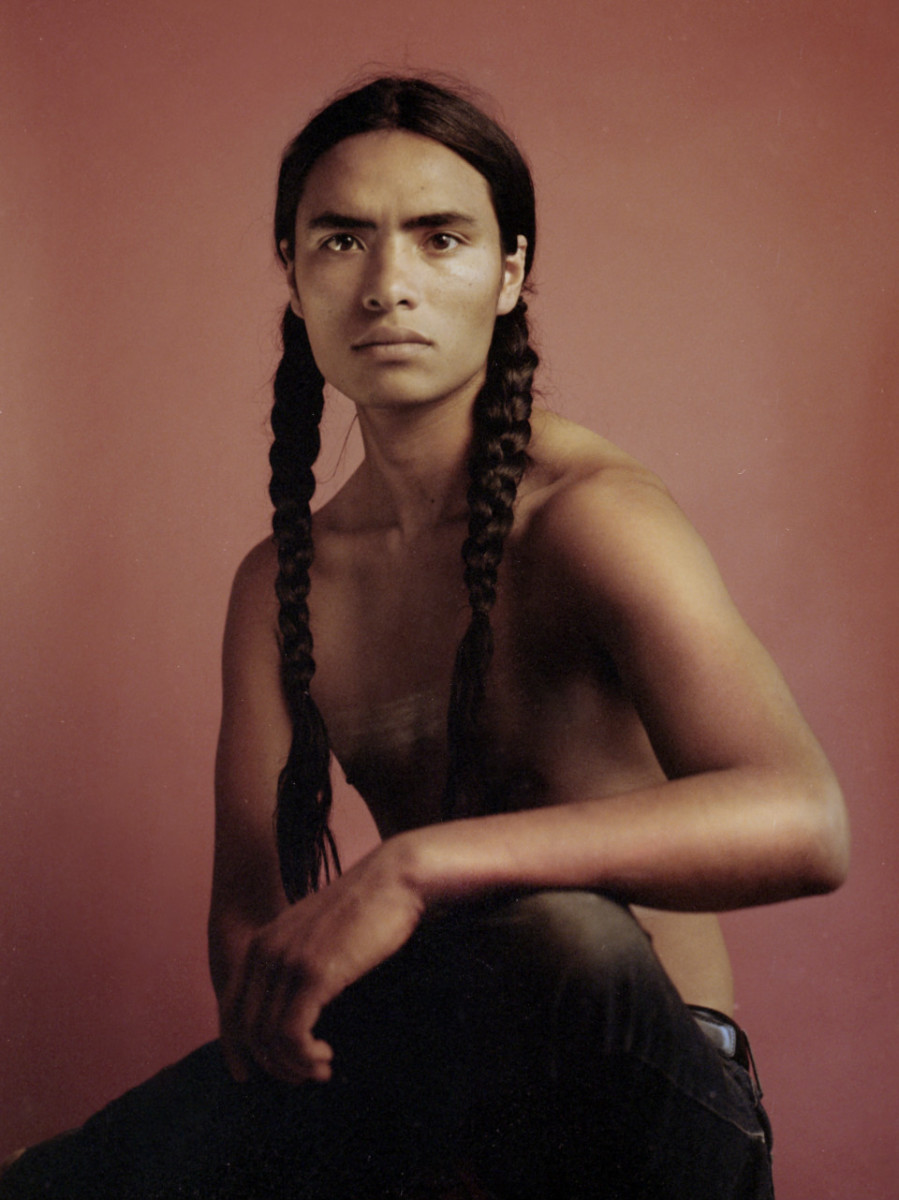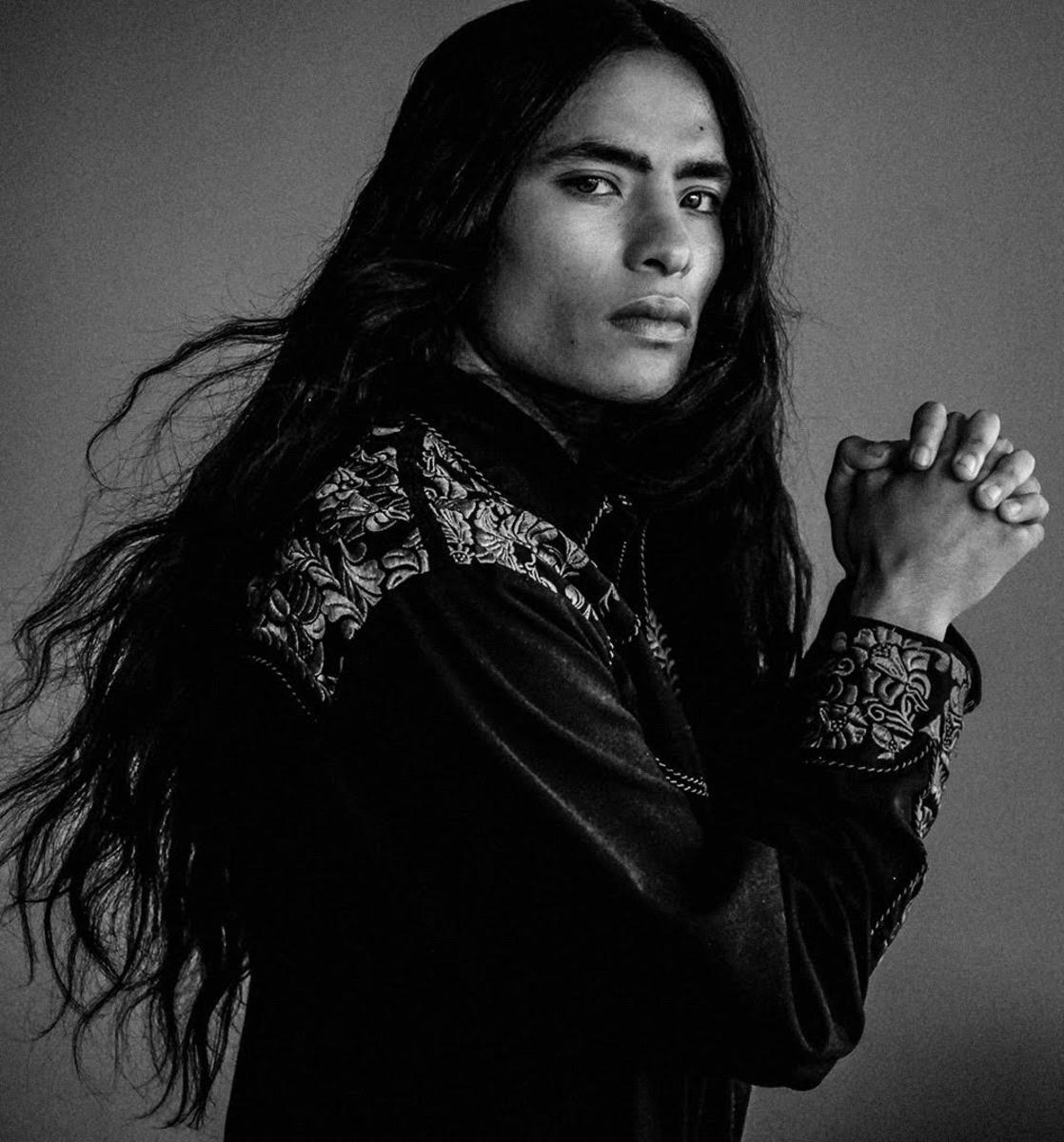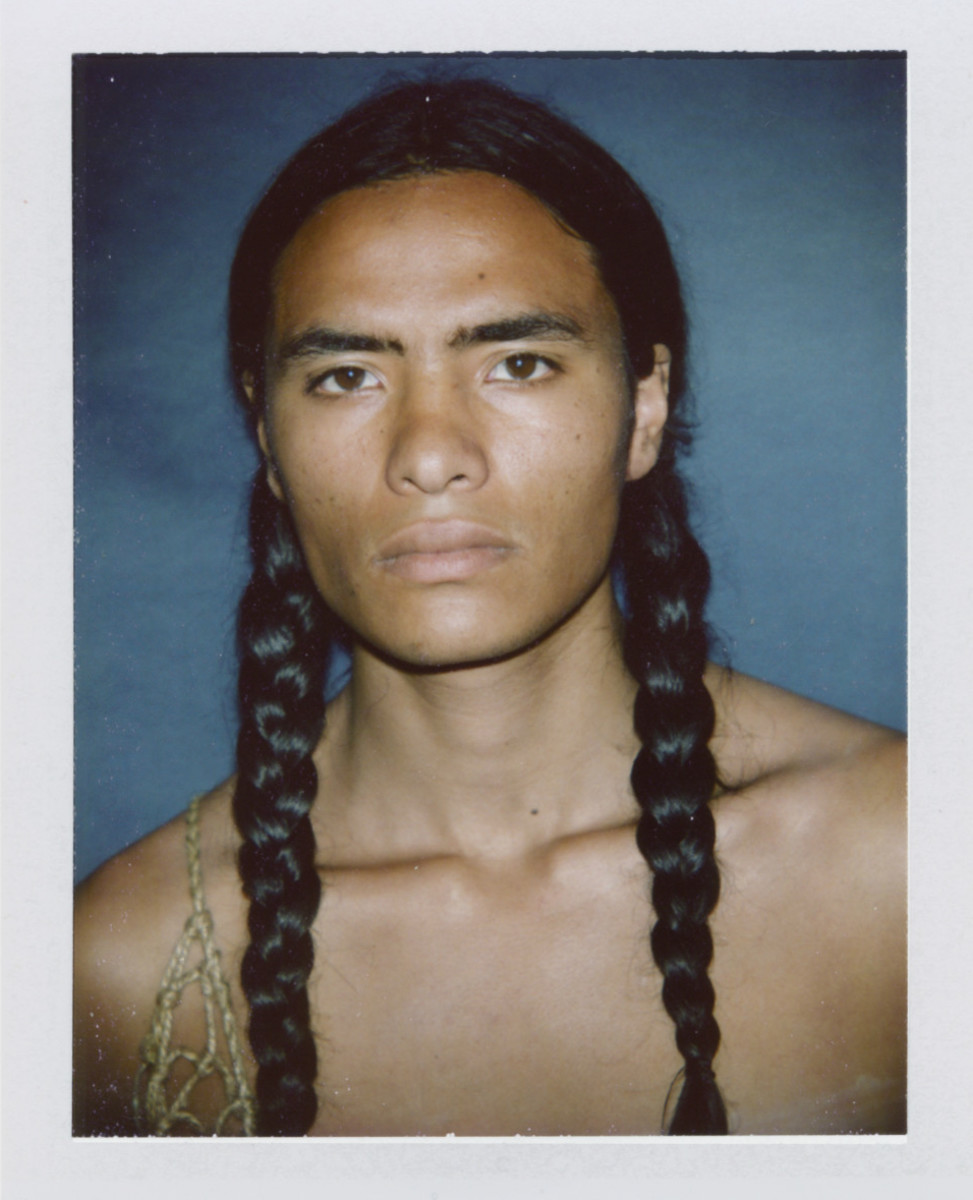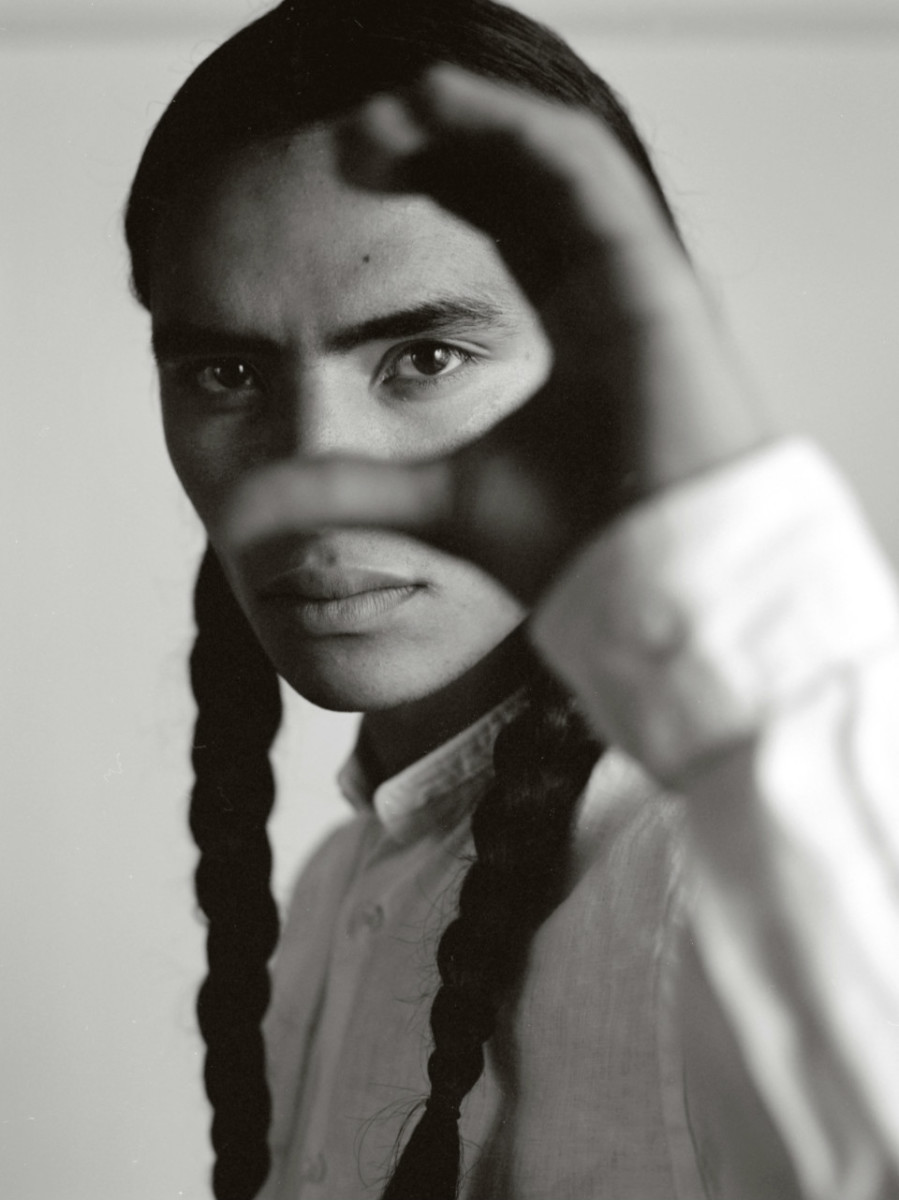But even the briefest survey of Haatepah's online presence makes clear that the young model is intent on being known for more than his striking features. As the descendent of Kumeyaay, Cahuilla, Apache, Yaqui and Chichimeca-Guamares peoples, Haatepah has long prioritized advocating for Native communities.
"A lot of people have been taught for hundreds of years to kind of hate themselves for being Indigenous," he says on the phone. "I feel like it's important that people reclaim who they are."

For Haatepah, the issue is both systemic and personal. Adopted alongside his twin brother at age five by two non-Native dads into a largely non-Native community, Haatepah remembers being bullied as a kid for looking different than his peers. "It was hard growing up in a place that wasn't very diverse," he says.
But the issue went beyond the school cafeteria. Though one of his fathers was supportive of Haatepah and his brother seeking out more knowledge and connection to their Native roots, the other wasn't — and when the more supportive parent died while the twins where just 17, their other dad began to make life at home increasingly difficult for them.
"He would say racist things at the dinner table, like 'don't become a drunken Indian,'" Haatepah explains. "Me and my brother didn't stick up for ourselves until we reached a boiling point. And then we told him, 'We're not going to take this kind of verbal abuse anymore,' and we left for Los Angeles. We didn't have much of a plan but to stay with our friend. We were homeless for a good bit."
As painful as some parts of his personal history have been, Haatepah takes pride in the resilience that's helped him survive tough circumstances — and sees that resilience as part of his heritage. As an adult, he's has gotten involved with a host of organizations aimed at championing Native voices, from the Native American Club at his college to the Student Council of Indian Tribal Nations, the International Indigenous Youth Council and the American Indian Movement. Haatepah and his brother also started an organization of their own, called the Indigenous Alliance Movement.
We chatted on the phone about the complexities of mixing activism with the need to earn a paycheck, how fashion brands can avoid cultural appropriation and more. Read on for the highlights from our conversation.

What role did social media play in you getting discovered?
My brother and I would take pictures because I thought it was fun. I've always had my own style. I'm into Western wear — like boots, a belt buckle and Indigenous jewelry. That caught the attention of my mother agent, Daniel Peddle. I got signed to Look Model Agency. I started to get a bunch of jobs. Then I got signed to Storm LA. Now my brother's gotten signed too.
I decided to take the gamble to come to Los Angeles with nothing and pursue this dream of modeling because I was making good money [doing it] in San Francisco. I went out on a limb, and here I am today. I've been self sufficient. My Instagram has been growing. I've been able to do all the activism that I love to do. I love to be an advocate for my people and use the platform that I have to spread awareness about issues like Indigenous children at the border in concentration camps, missing and murdered Indigenous women, things like that.
Was it hard to learn about your heritage since you were adopted out of the foster care system?
I decided to take the gamble to come to Los Angeles with nothing and pursue this dream of modeling because I was making good money [doing it] in San Francisco. I went out on a limb, and here I am today. I've been self sufficient. My Instagram has been growing. I've been able to do all the activism that I love to do. I love to be an advocate for my people and use the platform that I have to spread awareness about issues like Indigenous children at the border in concentration camps, missing and murdered Indigenous women, things like that.
Was it hard to learn about your heritage since you were adopted out of the foster care system?
I didn't have the connections at all at first. I just knew I was Native. But I began to seek. I went to powwows. I got involved with the Native community in the Bay Area. I started to seek out my elders and go to sweat lodge and a bunch of different ceremonies and learn and reclaim who I was. I have to thank my dad because he's the one who really pushed that.
When I was 18 years old, I met my biological family. Then I was able to pinpoint the tribal backgrounds that I have. It was a lot to handle. It's a really sad history, but that history is also part of our resilience, cause we're still here. A lot of people are like, "Natives are all gone. They're all extinct." But no, we're here to stay.
I'm Kumeyaay, Cahuilla, and some Apache and Yaqui, and other tribes. But I also have Chichimeca-Guamares blood, and I feel that's very important to represent. Since the Spanish conquistadors, there's been a lot of people telling Indigenous Mexicans that it's bad to be Indigenous.
What are your long term career goals?
When I was 18 years old, I met my biological family. Then I was able to pinpoint the tribal backgrounds that I have. It was a lot to handle. It's a really sad history, but that history is also part of our resilience, cause we're still here. A lot of people are like, "Natives are all gone. They're all extinct." But no, we're here to stay.
I'm Kumeyaay, Cahuilla, and some Apache and Yaqui, and other tribes. But I also have Chichimeca-Guamares blood, and I feel that's very important to represent. Since the Spanish conquistadors, there's been a lot of people telling Indigenous Mexicans that it's bad to be Indigenous.
What are your long term career goals?
I'm taking a break from school now, but I'm thinking about going to the Institute of American Indian Arts in Santa Fe, New Mexico. I want to learn silversmithing and make jewelry.
Eventually, when the time comes after I'm done with modeling, I want to try acting. It doesn't have to be a major role. I'm okay with being a background actor. I just want to give it a shot. Another smaller goal is that I want to open my own martial arts gym because I'm into Brazilian jiu jitsu and wrestling. I'd like to do that for the youth, have it more like a free club. It would just be like, I'm doing this for fun and to give back to my community.
Eventually, when the time comes after I'm done with modeling, I want to try acting. It doesn't have to be a major role. I'm okay with being a background actor. I just want to give it a shot. Another smaller goal is that I want to open my own martial arts gym because I'm into Brazilian jiu jitsu and wrestling. I'd like to do that for the youth, have it more like a free club. It would just be like, I'm doing this for fun and to give back to my community.

What role do you think fashion can play in activism or advocacy?
I feel like it's huge because the way you dress says who you are and what you represent. It's the first thing when you walk into a room, especially when you're public speaking — how you have your hair, how you're dressed, your clothes — that all leaves a statement. It reflects how you want to express yourself.
Is the environmental impact of making clothing something you're thinking about as you enter the world of modeling?
Is the environmental impact of making clothing something you're thinking about as you enter the world of modeling?
I just modeled for this company that makes clothing for people who are defending Standing Rock against the Dakota Access Pipeline. It was talking about land rights, and defending our earth. Because when these companies come in and drill, it's destroying the lands and the ecosystems around it. And it doesn't just effect Native communities. It effects all communities. Water is life.
At the end of the day there's only so much I can do, though. I try to mostly model for clothing that I know is eco-friendly. But I was borderline homeless coming here. So sometimes I have to do a job in order to make ends meet. That doesn't mean I buy the clothes that I model for.
The two factors that I really take into consideration are first, how bad they're damaging the earth, because I don't want to support a brand that's basically destroying the Amazon. And then second — recently there was this Dior campaign that was like cultural appropriation times a million. I could never do something like that. I would never sell out my people like that.
If there are fashion projects or brands that want to hire Native models but aren't Native-led, what should they keep in mind in order to do that in a way that doesn't fetishize or exoticize those involved?
At the end of the day there's only so much I can do, though. I try to mostly model for clothing that I know is eco-friendly. But I was borderline homeless coming here. So sometimes I have to do a job in order to make ends meet. That doesn't mean I buy the clothes that I model for.
The two factors that I really take into consideration are first, how bad they're damaging the earth, because I don't want to support a brand that's basically destroying the Amazon. And then second — recently there was this Dior campaign that was like cultural appropriation times a million. I could never do something like that. I would never sell out my people like that.
If there are fashion projects or brands that want to hire Native models but aren't Native-led, what should they keep in mind in order to do that in a way that doesn't fetishize or exoticize those involved?
I think they should hire cultural consultants to make sure everything is authentic and legit. And they have to be careful about how much of a spin they put on what models are wearing. If it's kind of a mix, say they're wearing like a [traditional] necklace but with some more modern clothing, I think that's okay. But if they're copying someone's full-on regalia, that's kind of crossing the line because it's taking what's traditional and sacred to a lot of Native communities. They just need to have that conversation with the model and with some sort of cultural consultant.

Tell me a little bit more about the different forms that advocacy has taken for you.
I'm part of like three or four different organizations. Basically we go protest different things. It's always peaceful protesting with Natives. We're pretty quiet.
For example, we went to the Washington Redskins to protest their mascot. It's disrespectful. We had signs that said, "We are not your mascot. We're not a joke. We're not a caricature." It's just very stereotypical and paints a bad picture. I don't think that's a good example to set for our kids.
I [participated] in the climate march, and I spoke there and I offered the water song. And in March we went to a detention center in Los Angeles. We were talking about the kids in detention centers, honoring them and spreading awareness.
For example, we went to the Washington Redskins to protest their mascot. It's disrespectful. We had signs that said, "We are not your mascot. We're not a joke. We're not a caricature." It's just very stereotypical and paints a bad picture. I don't think that's a good example to set for our kids.
I [participated] in the climate march, and I spoke there and I offered the water song. And in March we went to a detention center in Los Angeles. We were talking about the kids in detention centers, honoring them and spreading awareness.
You weren't born Haatepah — at what point did you start going by that name?
I got the name Haatepah from my auntie and uncle. They gave these names to me and my brother. It's important to reclaim those names because back in the mission era, we would be given names that were Spanish or that weren't Native. I feel like it's important to reclaim those names to honor our ancestors.
What are you hoping that you can accomplish through your modeling?
I hope I can give our people their pride back. A lot of people have been taught to hate themselves when they look in the mirror. I hope I can make a little boy or a little girl feel happy in their own skin and proud to be Indigenous.

No comments:
Post a Comment